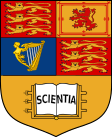
Central America is defined as a subregion of the Americas. This region is bordered by Mexico to the north, Colombia to the southeast, the Caribbean Sea to the east and the Pacific Ocean to the west and south. Central America consists of seven countries: El Salvador, Costa Rica, Belize, Guatemala, Honduras, Nicaragua and Panama. The combined population of Central America is estimated at 44.53 million (2016).
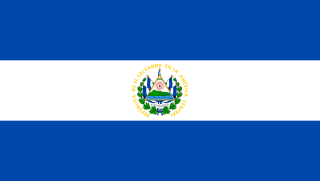
El Salvador, officially the Republic of El Salvador, is a country in Central America. It is bordered on the northeast by Honduras, on the northwest by Guatemala, and on the south by the Pacific Ocean. El Salvador's capital and largest city is San Salvador. As of 2018, the country had a population of approximately 6.42 million, making it the smallest and second-least populated country in Central America.

San Salvador is the capital and the most populous city of El Salvador and its eponymous department. It is the country's political, cultural, educational and financial center. The Metropolitan Area of San Salvador, which comprises the capital itself and 13 of its municipalities, has a population of 2,404,097.
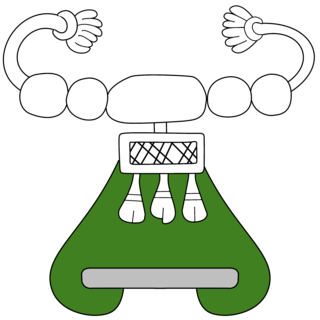
The Nahuas of El Salvador (Cuscatlan), better known as "Pipiles" in the academic literature, are an indigenous people who live in western El Salvador, which they call Cuscatlan. The Pipil language, or Nawat, belongs to the Nahuatl dialect group, which stretches from Durango in Mexico to El Salvador, and historically as far as the Nicoya Peninsula of Costa Rica. It is thought that the Pipil, along with the neighbouring Nicarao people, migrated from Central Mexico to their present location around 900 AD, after the Chichimeca-Toltec civil war. As they settled in the area, they founded the city-state of Cuscatlan, absorbed many other preexisting polities, and intermarried with the native peoples, mostly Lenca, Poqomam, and Xinca.

Indian Institute of Technology Roorkee is a premier public technical and research university located in Roorkee, Uttarakhand, India, headed by Director Ajit Kumar Chaturvedi. It is formerly known as University of Roorkee (1949-2001) and Thomason College of Civil Engineering (1847-1949). Established in 1847 in British India by the then lieutenant governor, Sir James Thomason, it is the oldest technical institution in Asia. It was given university status in 1949 and was converted into an Indian Institute of Technology (IIT) in 2001, thus becoming the seventh IIT to be declared. IIT Roorkee has 22 academic departments covering Engineering, Applied Sciences, Humanities & Social Sciences and Management programs with a strong emphasis on scientific and technological education and research.

The University of Puerto Rico, Mayagüez Campus (UPRM) or Recinto Universitario de Mayagüez (RUM) in Spanish, is a public land-grant, sea-grant, space-grant university in Mayagüez, Puerto Rico. UPRM is the second-largest university campus of the University of Puerto Rico system. In 2009, the campus population was composed of 12,108 students, 1,924 regular staff members, and 1,037 members of the education staff. In 2013, the student population remained relatively steady at 11,838, but the instructional faculty dropped to 684. In the second semester of 2019 around 12,166 students where enrolled.

Antiguo Cuscatlán(colloquially known as Antiguo) is a municipality in the La Libertad department of El Salvador, and its eastern tip lays in San Salvador Department part of the Metropolitan Area of San Salvador, southwest of San Salvador and southeast of Santa Tecla. The population was 48,027 at the 2010 census. Antiguo Cuscatlán can be translated as Old Jeweled City: Antiguo means ancient or old in Spanish, and Cuscatlán means jeweled city in Nahuat. The city used to be the capital of the Pipil or Cuzcatecs, before the Spanish conquest of the New World.

Suchitoto is a municipality in the Department of Cuscatlán, El Salvador that has seen continuous human habitation long before Spanish colonization. Within its municipal territory, Suchitoto holds the site of the original founding of the Villa of San Salvador in 1528 that existed for a short time before the site was abandoned. In more recent times, the municipality has prospered even after the severe effects of civil war in El Salvador that lasted between 1980 - 1992 and saw the population of Suchitoto decrease from 34,101 people in 1971 to 13,850 by 1992. It has become an important tourist destination partly due to its well conserved colonial architecture and cobblestone roads that provide a sense of Spanish colonial living. This rise in tourism has attracted service sector businesses to open up in the small city including hostels, restaurants, and picturesque cafes. As a result of tourism, many arts and cultural spaces have opened up in Suchitoto that are also providing positive alternative opportunities for youth in the community. According to the 2007 Official Census, the small city has a population of 24,786 people with 7,654 people living in the urban area and 17,132 people living in the rural communities.
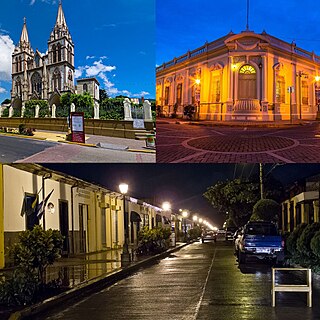
Santa Tecla is a municipality in the La Libertad department of El Salvador. It is the capital of the department of La Libertad.

El Salvador International Airport Saint Oscar Arnulfo Romero y Galdámez, , previously known as Comalapa International Airport is an airport that serves San Salvador, El Salvador. It is located in the south central area of the country, in the city of San Luis Talpa, Department of La Paz, and occupies a triangular plain of 2519.8 acres, which borders the Pacific Ocean to the south, to the east with the Jiboa river, and to the northwest with the coastal highway. Being close to sea level, it allows aircraft to operate efficiently at maximum capacity. It is connected to the capital of San Salvador, El Salvador through a modern four-lane motorway, with 42 kilometers travel in an average time of 30 minutes.

Salvadorans, also known as Salvadorians or Salvadoreans, are people who identify with El Salvador, a country in Central America. Mestizos, people of mixed European and Amerindian heritage make up the bulk of the population in El Salvador. Most Salvadorans live in El Salvador, although there is also a significant Salvadoran diaspora, particularly in the United States, with smaller communities in other countries around the world.

The following outline is provided as an overview of and topical guide to El Salvador:
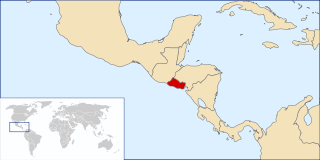
The following is an alphabetical list of topics related to the Republic of El Salvador.
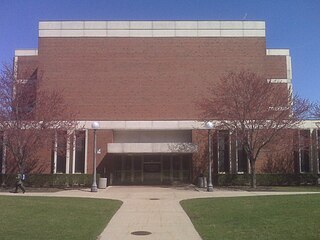
The Nathan M. Newmark Civil Engineering Laboratory, or Newmark Lab, located at 205 N. Mathews Avenue in Urbana, Illinois on the campus of the University of Illinois at Urbana–Champaign, houses the university's Department of Civil and Environmental Engineering. The Lab was built in 1967, and has been modified and updated a number of times since then. The facility was named after professor and department head Nathan M. Newmark after his death.

The Department of Civil and Environmental Engineering is the academic department at Imperial College London dedicated to civil engineering. It is located at the South Kensington Campus in London, along Imperial College Road. The department is currently a part of the college's Faculty of Engineering, which was formed in 2001 when Imperial College restructured. The department has consistently ranked within the top five on the QS World University Rankings in recent years.
Water resources management in El Salvador is characterized by difficulties in addressing severe water pollution throughout much of the country's surface waters due to untreated discharges of agricultural, domestic and industrial run off. The river that drains the capital city of San Salvador is considered to be polluted beyond the capability of most treatment procedures.

SIMÁN is a department store from El Salvador, has 90 years of operation and currently has regionalized along Central America.

Tourism accounts for a large part of El Salvador's economy. It offers many natural attractions including, beaches, a mild tropical climate and lush landscapes. It also offers an important archaeological and ecological heritage, with colonial and pre-Columbian vestiges, and national reserves.

The February 2001 El Salvador earthquake occurred with a moment magnitude of 6.6 on 13 February at 14:22:05 UTC. The epicentre was 15 miles (30 km) E of San Salvador, El Salvador. At least 315 people were killed, 3,399 were injured, and extensive damage affected the area. Another 16,752 homes were damaged and 44,759 destroyed. The most severe damage occurred in the San Juan Tepezontes-San Vicente-Cojutepeque area, though it was felt throughout the country and in neighboring Guatemala and Honduras. Landslides occurred in many areas of El Salvador.

The Spanish conquest of El Salvador was the campaign undertaken by the Spanish conquistadores against the Late Postclassic Mesoamerican polities in the territory that is now incorporated into the modern Central American nation of El Salvador. El Salvador is the smallest country in Central America, and is dominated by two mountain ranges running east–west. Its climate is tropical, and the year is divided into wet and dry seasons. Before the conquest the country formed a part of the Mesoamerican cultural region, and was inhabited by a number of indigenous peoples, including the Pipil, the Lenca, the Xinca, and Maya. Native weaponry consisted of spears, bows and arrows, and wooden swords with inset stone blades; they wore padded cotton armour.


















